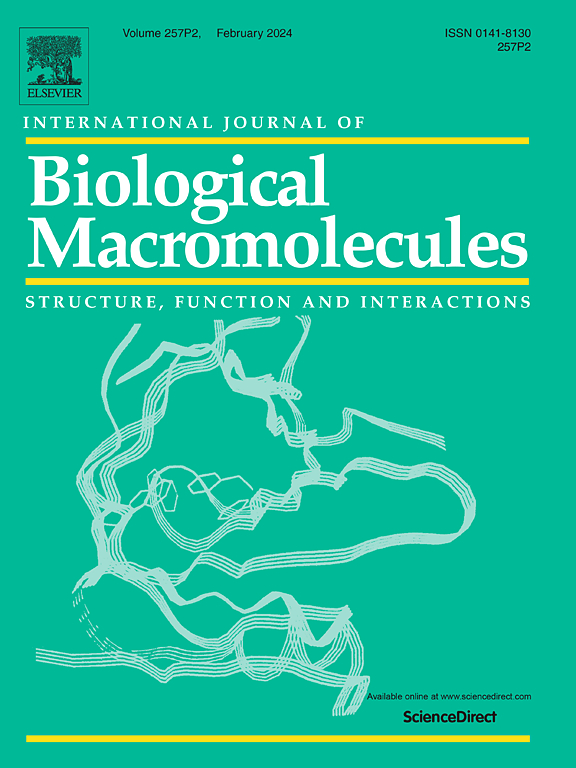Development of Saccharomyces cerevisiae accumulating excessive amount of glycogen and its effects on gut microbiota in a mouse model
IF 8.5
1区 化学
Q1 BIOCHEMISTRY & MOLECULAR BIOLOGY
International Journal of Biological Macromolecules
Pub Date : 2024-12-01
DOI:10.1016/j.ijbiomac.2024.137589
引用次数: 0
Abstract
Saccharomyces cerevisiae accumulates glycogen, a hyperbranched glucose polymer with multiple bio-functionalities. In this study, mutants of S. cerevisiae that accumulate excessive amounts of glycogen were developed through UV mutagenesis. From over 30,000 mutants, the mutant strain CEY1, which exhibited the highest glycogen production, was selected using iodine vapor screening. The glycogen structures of wild type (WT) and CEY1 were analyzed and found to be relatively similar in molecular weight, hydrodynamic diameter, and side-chain distribution. The glycogen from CEY1 contained long branches (DP >12) 23.6 % greater than those in Escherichia coli TBP38. In addition, WT and CEY1 glycogen showed 32 %–34 % digestibility, which is significantly lower than E. coli glycogen. The glycogen content in dried CEY1 cells was increased to 21.7 % during laboratory-scale fed-batch fermentation. Glycogen with a homogeneous structure was accumulated to 17.5 % (w/w dried cell), and the total glucan content was increased by 33.2 % during large-scale fed-batch fermentation. In a mouse model, a diet containing 30 % CEY1 increased the production of butyrate and populations of beneficial bacteria, including Bacteroides and Parabacteroides. Therefore, glycogen from CEY1 exhibits a distinct structure from other polysaccharides, with notably slow and low digestibility, thereby indicating its potential application as a dietary supplement.
小鼠模型中积累过量糖原的酿酒酵母的发育及其对肠道微生物群的影响
酿酒酵母会积累糖原,这是一种具有多种生物功能的超支化葡萄糖聚合物。在这项研究中,通过紫外线诱变,培育出了积累过量糖原的酿酒酵母突变体。通过碘蒸气筛选法,从 30,000 多个突变体中选出了糖原产量最高的突变株 CEY1。分析发现,野生型(WT)和 CEY1 的糖原结构在分子量、流体力学直径和侧链分布方面相对相似。CEY1 的糖原含有长枝(DP >12),比大肠杆菌 TBP38 中的长枝多 23.6%。此外,WT和CEY1糖原的消化率为32%-34%,明显低于大肠杆菌糖原。在实验室规模的饲料批量发酵过程中,干燥的 CEY1 细胞中的糖原含量增至 21.7%。在大规模饲料批量发酵过程中,具有均匀结构的糖原积累到了17.5%(干燥细胞重量),总葡聚糖含量增加了33.2%。在小鼠模型中,含有 30 % CEY1 的饮食增加了丁酸盐的产量和有益细菌的数量,包括 Bacteroides 和 Parabacteroides。因此,来自 CEY1 的糖原具有不同于其他多糖的结构,消化速度明显较慢且消化率较低,这表明它有可能被用作膳食补充剂。
本文章由计算机程序翻译,如有差异,请以英文原文为准。
求助全文
约1分钟内获得全文
求助全文
来源期刊
CiteScore
13.70
自引率
9.80%
发文量
2728
审稿时长
64 days
期刊介绍:
The International Journal of Biological Macromolecules is a well-established international journal dedicated to research on the chemical and biological aspects of natural macromolecules. Focusing on proteins, macromolecular carbohydrates, glycoproteins, proteoglycans, lignins, biological poly-acids, and nucleic acids, the journal presents the latest findings in molecular structure, properties, biological activities, interactions, modifications, and functional properties. Papers must offer new and novel insights, encompassing related model systems, structural conformational studies, theoretical developments, and analytical techniques. Each paper is required to primarily focus on at least one named biological macromolecule, reflected in the title, abstract, and text.

 求助内容:
求助内容: 应助结果提醒方式:
应助结果提醒方式:


